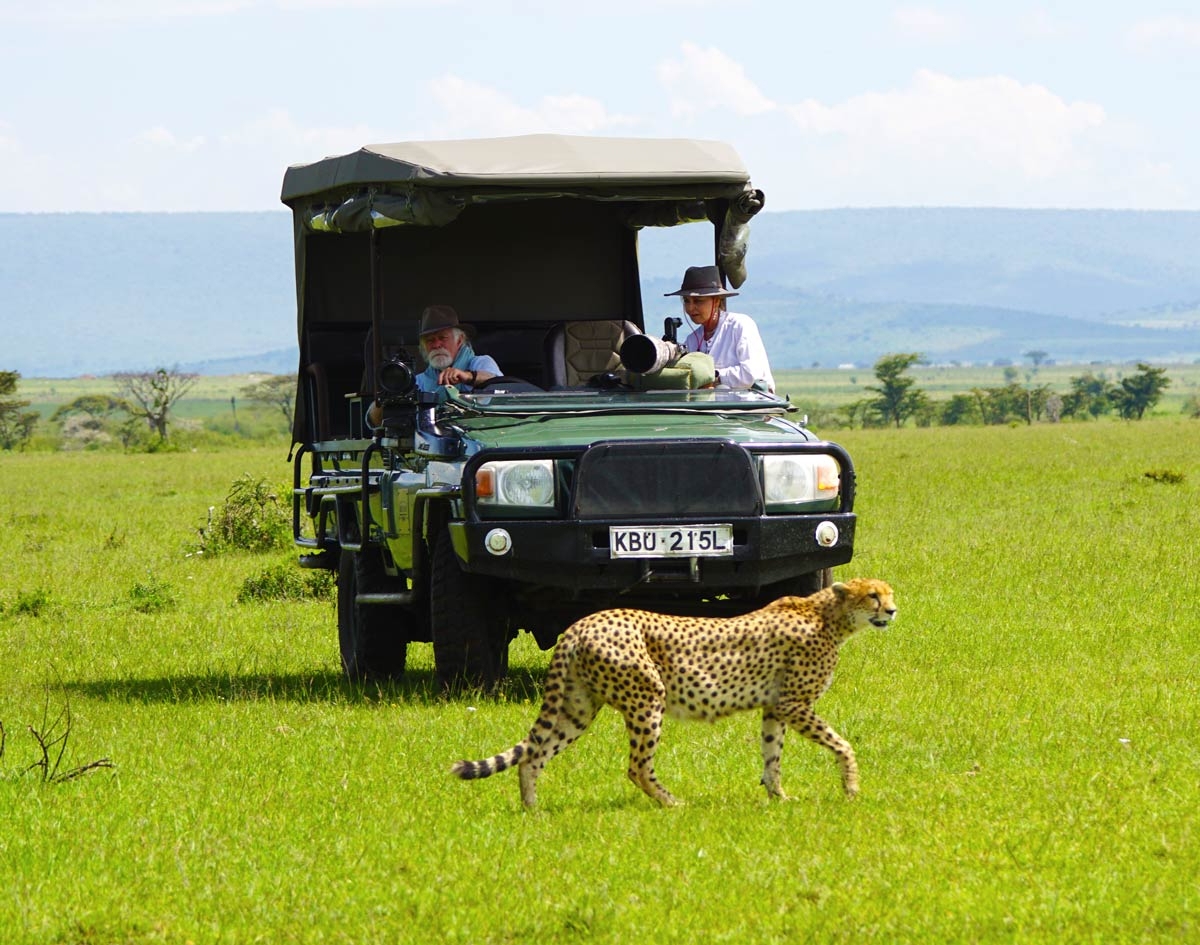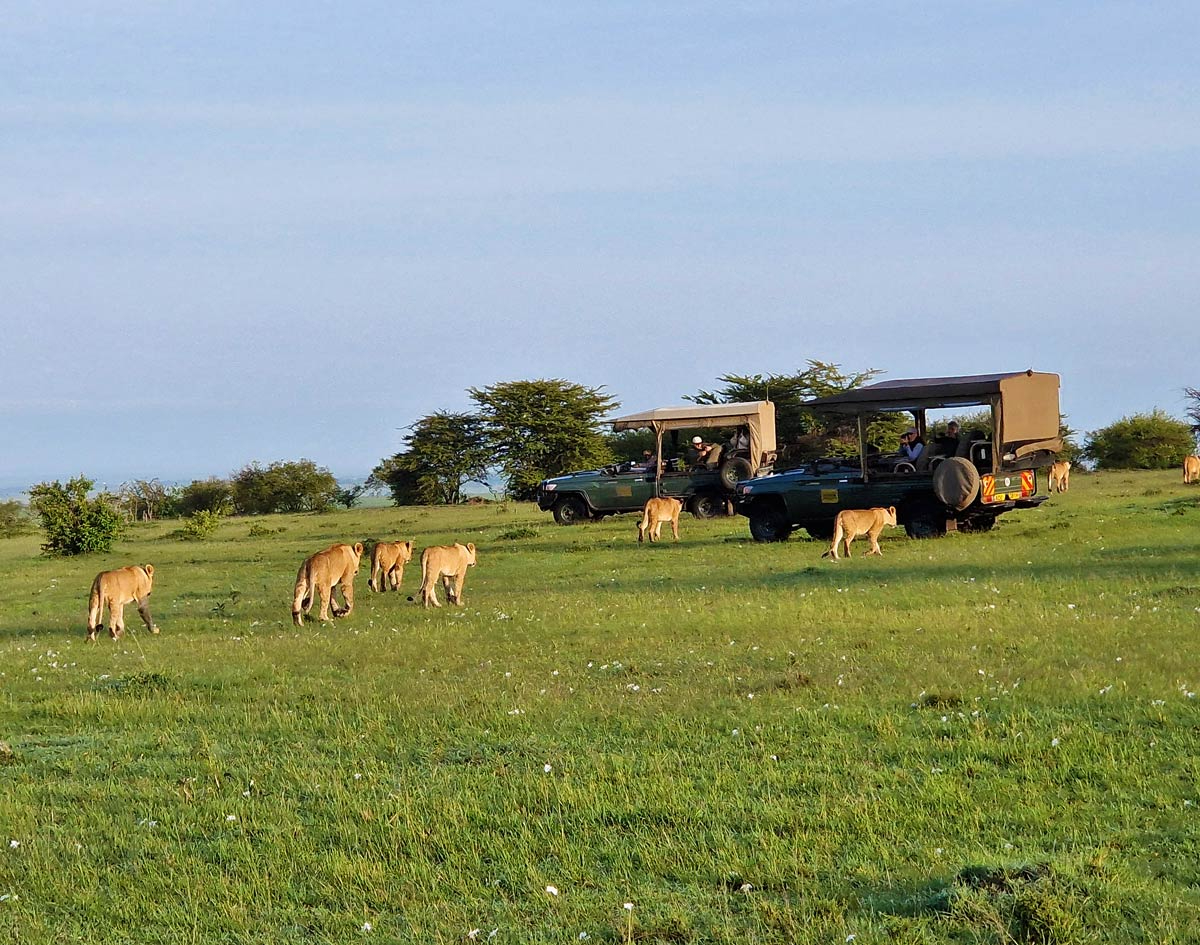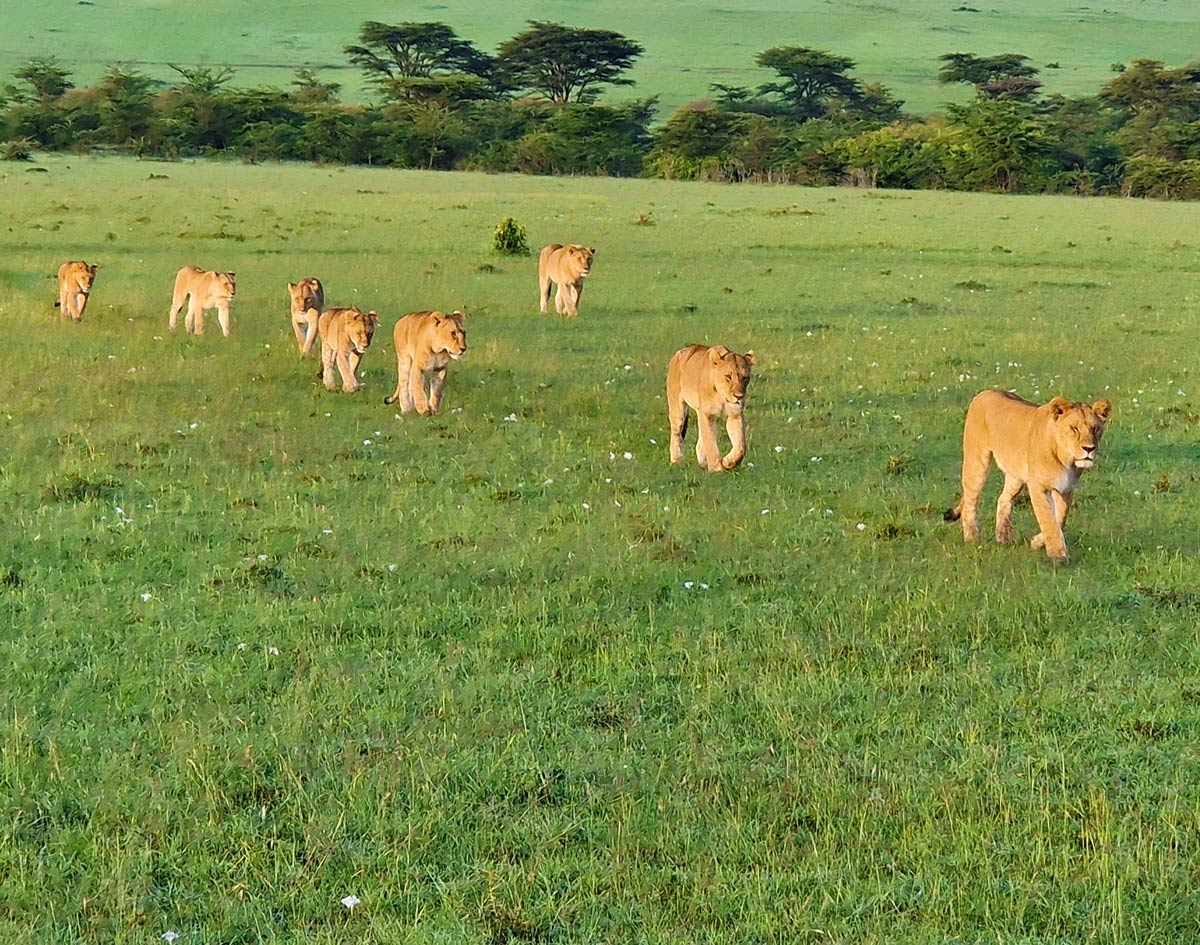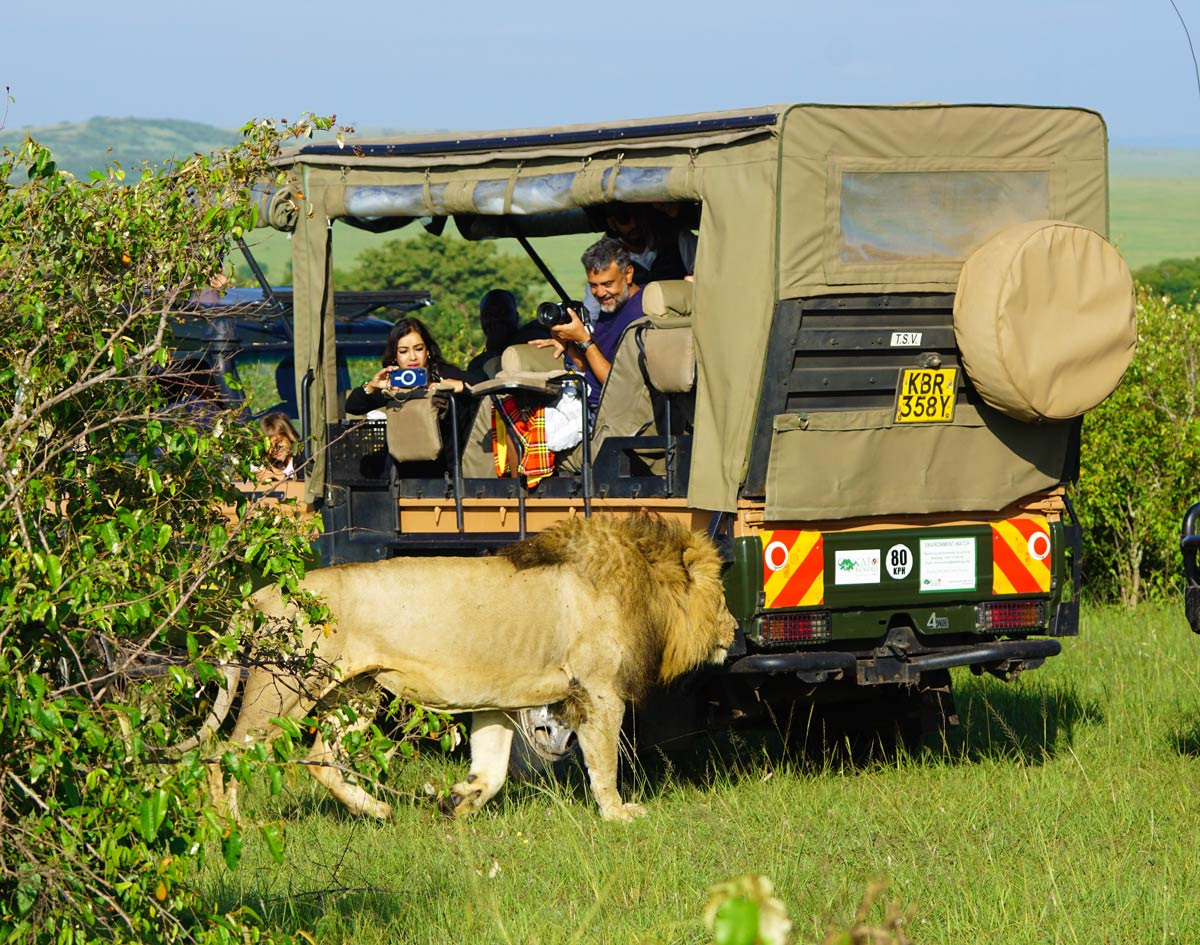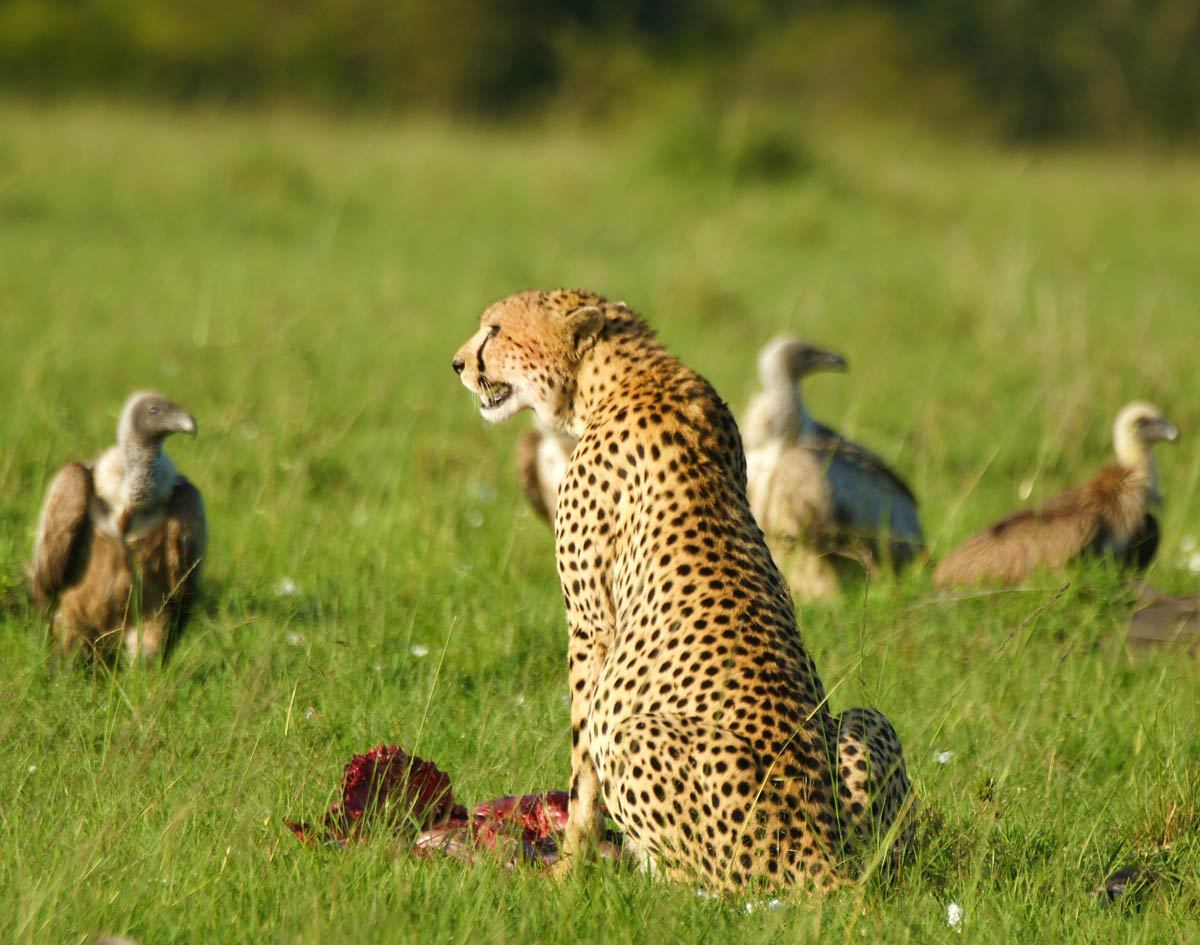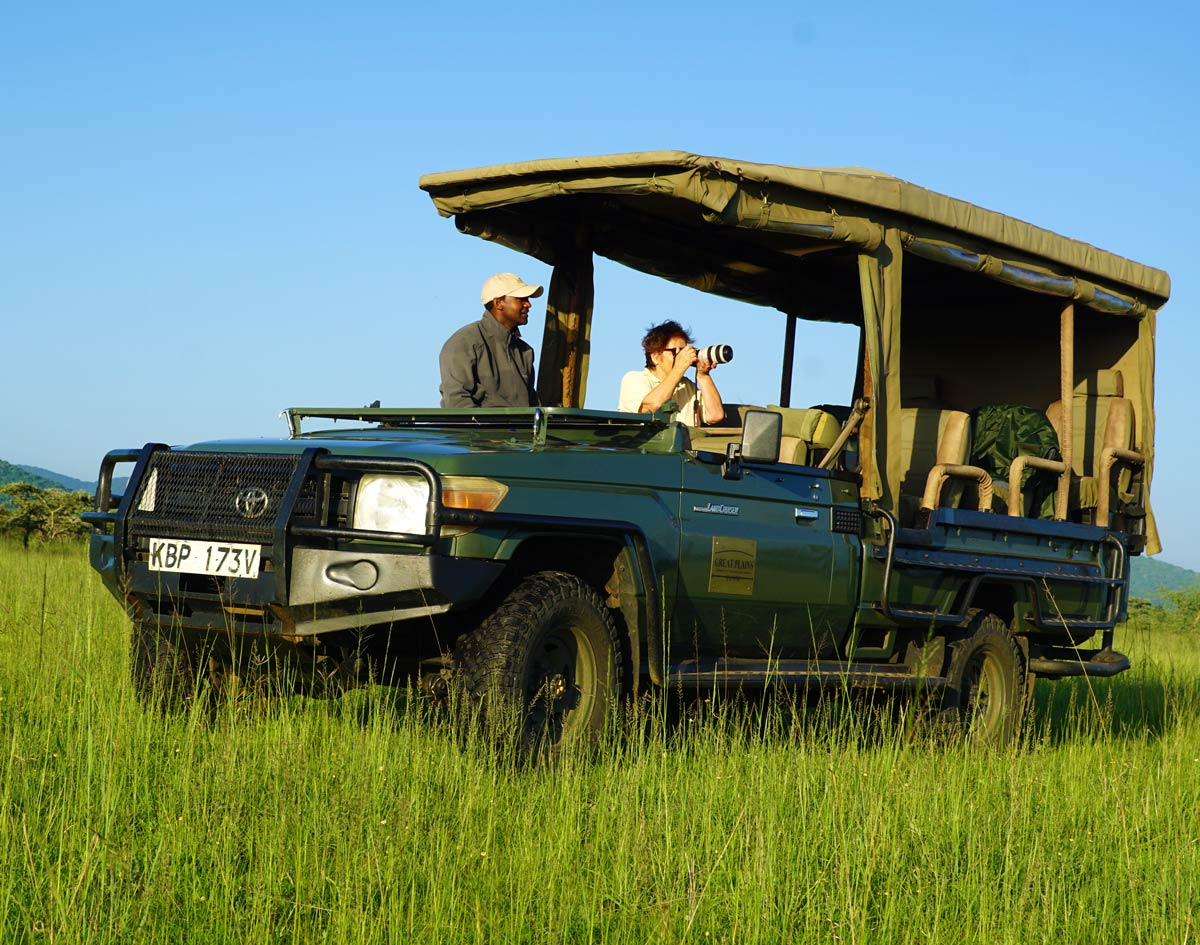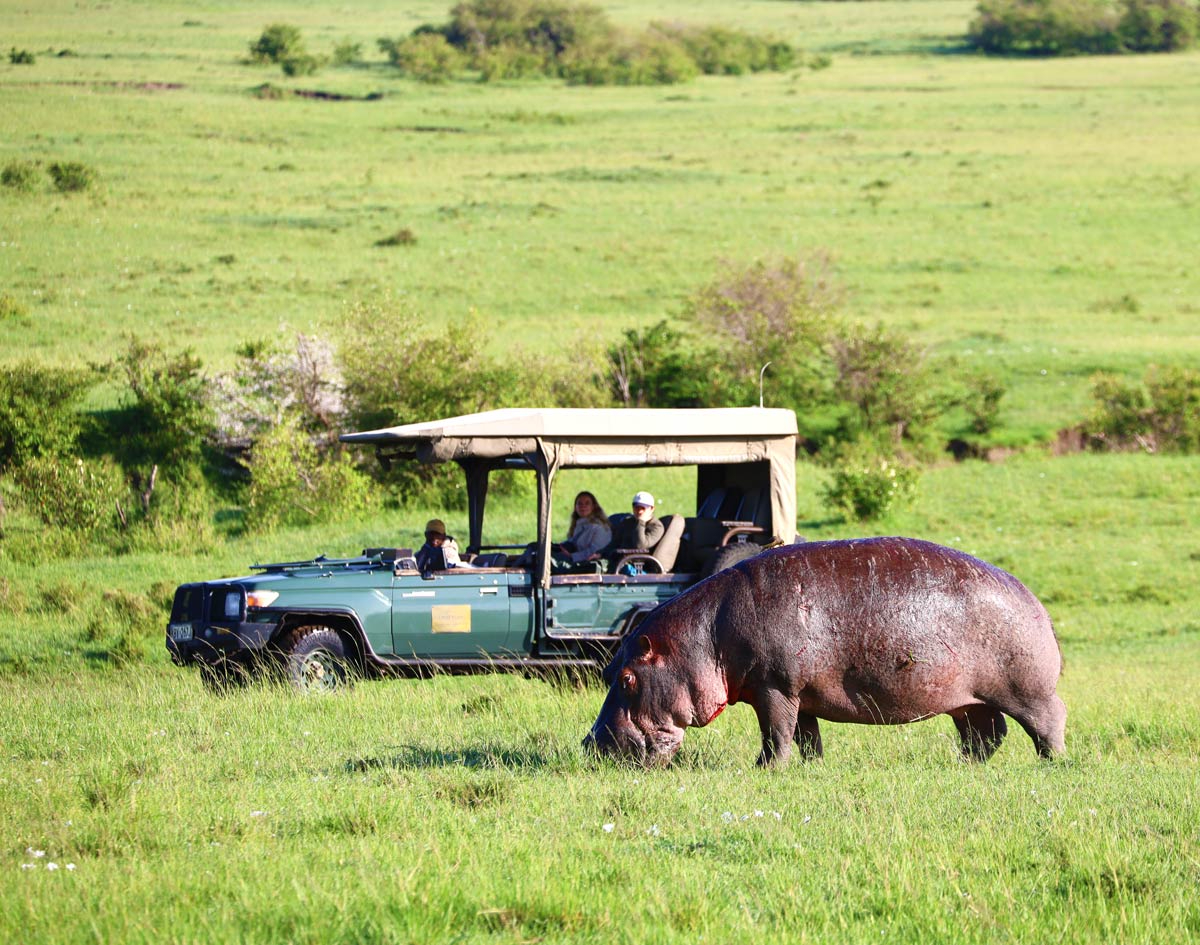It does not get any better than this! The Great Plains Conservation Camps and Lodges

© Image: Henry Jedelsky
It does not get any better than this! Great Plains Conservation is setting new standards with its camps and lodges in Botswana, Zimbabwe, and Kenya. Our Africa specialists, Elisabeth and Henry Jedelsky, were invited to Kenya and met two African celebrities.
The Ol Donyo Lodge is located at the foot of the Chyulu Mountains near Tsavo West and Amboseli National Park. Ernest Hemingway wrote about the enchanting landscape in his book "The Green Hills of Africa". At the end of December, after the "Short Rain Period", the mountains shimmer in the morning light, and the vast plain gleams in fresh green, interspersed with small white flowers. A small twin-engine aircraft from Safari Link, piloted by a female pilot, brought us here from Nairobi in just under an hour, where an open Toyota Land Cruiser was already waiting. On the way to the lodge, we encounter three cheetah brothers who have killed a Thompson's gazelle. The savannah is dotted with giraffes, two bulls are fighting among the acacia trees, watched by a group of riders. The lodge offers not only bush walks and game drives but also its own stable for horseback riding and excursions. At Ol Donyo, a lunch with selected delicacies awaits us. We learn that at Great Plains Lodges, all drinks, including all alcoholic ones, are always included. In each camp, you can taste wines from around the world, mostly from South Africa, in the on-site wine cellar. Each of the five housing units consists of a spacious room with adjoining rooms. From the bed, if you push aside the mosquito net, you can see Mount Kilimanjaro through the panoramic window.
The Ol Donyo Lodge is located at the foot of the Chyulu Mountains near Tsavo West and Amboseli National Park. Ernest Hemingway wrote about the enchanting landscape in his book "The Green Hills of Africa". At the end of December, after the "Short Rain Period", the mountains shimmer in the morning light, and the vast plain gleams in fresh green, interspersed with small white flowers. A small twin-engine aircraft from Safari Link, piloted by a female pilot, brought us here from Nairobi in just under an hour, where an open Toyota Land Cruiser was already waiting. On the way to the lodge, we encounter three cheetah brothers who have killed a Thompson's gazelle. The savannah is dotted with giraffes, two bulls are fighting among the acacia trees, watched by a group of riders. The lodge offers not only bush walks and game drives but also its own stable for horseback riding and excursions. At Ol Donyo, a lunch with selected delicacies awaits us. We learn that at Great Plains Lodges, all drinks, including all alcoholic ones, are always included. In each camp, you can taste wines from around the world, mostly from South Africa, in the on-site wine cellar. Each of the five housing units consists of a spacious room with adjoining rooms. From the bed, if you push aside the mosquito net, you can see Mount Kilimanjaro through the panoramic window.
Derek Joubert, Chairman of Great Plains Conservancy and a famous wildlife filmmaker, has furnished each room of the lodges and the spacious tents of all his camps stylishly and individually with reading chairs, desks, safari trunks, and huge animal photographs by his wife, Beverly. Two binoculars, often from Swarovski, and a Canon EOS 5D with two powerful zoom lenses are included, as well as chargers for all plugs, insect repellent, and reading glasses. Additionally, the latest photo books by Beverly Joubert are provided. The bathroom features a freestanding bathtub, indoor and outdoor showers, and a terrace with loungers, leading to a private, crescent-shaped swimming pool that allows more than just two laps. From the daybed on the rooftop terrace, you can admire the incredible starry sky at night. The morning game drive takes us to two large "Tuskern" elephants, huge bull elephants currently crossing over from the nearby Amboseli National Park. Back at the lodge, we enjoy a four-course meal in the library next to the pool, where colorful agama lizards frolic, enjoying the view of the vast plain and the waterhole just like us. Unfortunately, the red light of the spotlight disables our cameras during the night game drive. So, we focus on cheetahs, spring hares, and the constellations of Orion, Capella, and the fantastic Milky Way. The early morning game drive leads through the open woodland to an acacia tree where a bush breakfast awaits us: A set table with a carpet and two chefs provide everything needed. The Maasai waitress, Koro, opens a bottle of Taittinger Champagne, which we empty while gazing at Mount Kilimanjaro. What an incredible luxury in Africa!
The next day, we continue our journey: Once again, a female pilot takes us, with the snow-capped peak of Mount Kilimanjaro to our left and the water bodies of the Amboseli reserve below us, back to Nairobi and onwards over the impressive rift valley to the highlands of the world-famous Masai Mara, the "spotted land." The renowned Masai Mara National Reserve was established as early as 1948 and has been expanded several times since then. From 2005 onwards, the new "Conservancies" were established north of this protected area. The land still belongs to individual Masai tribes and is leased by private camps and lodges. These areas refrain from extensive cattle farming and agriculture. Instead, antelopes graze, lions and cheetahs roam, and elephants and even some rhinos wander the vast plains. Between June and October, the entire region is the stage for the famous "migration," the movement of hundreds of thousands of gnus and zebras migrating from the Serengeti, providing spectacular images of their river crossings, known as the "Crossings." In May 2006, the Olare Motorogi Conservancy was established, covering approximately 14,000 hectares, equivalent to about ten percent of the "original" Masai Mara National Reserve. In addition, there are five other Conservancy protected areas, all with private camps and lodges. Boundaries exist only on paper; the gnus, zebras, lions, and cheetahs wander freely, and if the daily fee is paid, safari vehicles are allowed to follow the wildlife in both directions. We land at the Ol Kiombo Airstrip on the Central Plains, where our drive guide Nancy awaits us with her Land Cruiser. She is an unmarried Masai from a nearby village and has been a fully trained guide for seven years after studying in Nairobi. I recall: In August, we encountered a woman as a guide in Zambia. Africa's women not only conquer the skies as pilots but also the wilderness as guides and camp managers.
The great gnu migration has already passed through here, countless topis with their newborn calves, majestic elands, impalas, Grant's gazelles, kongonis, and even the elegant giraffe gazelles populate the savannah and delight in the fresh greenery. Cheetahs play with their young, and spotted hyenas enjoy mud baths. We head north into the Olare Motorogi Conservancy and are already expected at the Mara Expedition Camp, which boasts only six tents but 36 staff members. We enjoy two wonderful days with the luxury that Great Plains Conservancy offers here. In the evening, we experience a show-cooking event by the Masai chefs of the camp, accompanied by their old, often melancholy songs. There's even a pool mounted on an old GMC truck. And as always, Wi-Fi intentionally works only in the individual tents, guests are meant to enjoy and engage in conversation. Unfortunately, we have to cancel a visit to the Marsh Pride lion pride, famous for countless television documentaries, because of a flooded river. Instead, Nancy takes us to a lion couple.
The great gnu migration has already passed through here, countless topis with their newborn calves, majestic elands, impalas, Grant's gazelles, kongonis, and even the elegant giraffe gazelles populate the savannah and delight in the fresh greenery. Cheetahs play with their young, and spotted hyenas enjoy mud baths. We head north into the Olare Motorogi Conservancy and are already expected at the Mara Expedition Camp, which boasts only six tents but 36 staff members. We enjoy two wonderful days with the luxury that Great Plains Conservancy offers here. In the evening, we experience a show-cooking event by the Masai chefs of the camp, accompanied by their old, often melancholy songs. There's even a pool mounted on an old GMC truck. And as always, Wi-Fi intentionally works only in the individual tents, guests are meant to enjoy and engage in conversation. Unfortunately, we have to cancel a visit to the Marsh Pride lion pride, famous for countless television documentaries, because of a flooded river. Instead, Nancy takes us to a lion couple.
Our final destination, the Mara Plains Camp, is situated directly on the Ntiakitiak River, also within the Olare Motorogi Conservancy. It was the first camp established by Great Plains Conservancy in Kenya and is probably the most spacious. It also offers only six tents. We estimate ours to be nearly seventy square meters. Unfortunately, we don't have time to try out the copper bathtub. Instead, we meet Beverly and Derek Joubert, who are also currently staying and working here. In the evening, Derek shares his story with me over a gin and tonic by the campfire: his camps in Botswana, Zimbabwe, and his plans in Kenya and Tanzania. Meanwhile, Beverly chats freely with other guests of the camp. The next day, we have the opportunity to accompany them to observe a cheetah with four cubs. It's a beautiful experience watching them work with a film camera and a giant telephoto lens. Time flies by, with hunting lions, a female leopard in a tree, and a nocturnal hippo calling right next to the tent. During the game drives, we are provided with additional practical comforts: thermos flasks on the seats during the early morning drive, rain ponchos for bad weather, protective glasses for insect swarms, and aluminum water bottles we can take home.
Soon it's time to head back to Nairobi, where the 60th Independence Day is being celebrated and our Ethiopian Airlines plane awaits. However, the departure is delayed because we are taking on board a prominent guest - the Ethiopian president, who appreciates the amenities of the business class.
Author: Henry Jedelsky
Soon it's time to head back to Nairobi, where the 60th Independence Day is being celebrated and our Ethiopian Airlines plane awaits. However, the departure is delayed because we are taking on board a prominent guest - the Ethiopian president, who appreciates the amenities of the business class.
Author: Henry Jedelsky






















